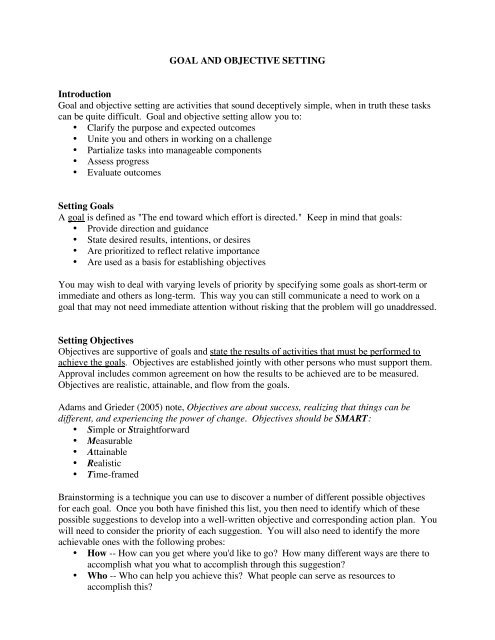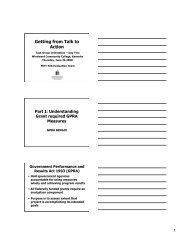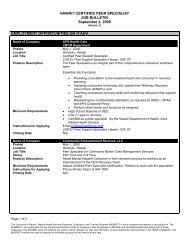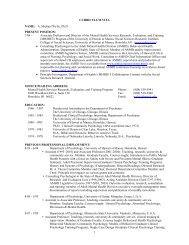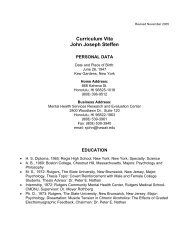Goal and Objective Setting
Goal and Objective Setting
Goal and Objective Setting
You also want an ePaper? Increase the reach of your titles
YUMPU automatically turns print PDFs into web optimized ePapers that Google loves.
GOAL AND OBJECTIVE SETTING<br />
Introduction<br />
<strong>Goal</strong> <strong>and</strong> objective setting are activities that sound deceptively simple, when in truth these tasks<br />
can be quite difficult. <strong>Goal</strong> <strong>and</strong> objective setting allow you to:<br />
• Clarify the purpose <strong>and</strong> expected outcomes<br />
• Unite you <strong>and</strong> others in working on a challenge<br />
• Partialize tasks into manageable components<br />
• Assess progress<br />
• Evaluate outcomes<br />
<strong>Setting</strong> <strong>Goal</strong>s<br />
A goal is defined as "The end toward which effort is directed." Keep in mind that goals:<br />
• Provide direction <strong>and</strong> guidance<br />
• State desired results, intentions, or desires<br />
• Are prioritized to reflect relative importance<br />
• Are used as a basis for establishing objectives<br />
You may wish to deal with varying levels of priority by specifying some goals as short-term or<br />
immediate <strong>and</strong> others as long-term. This way you can still communicate a need to work on a<br />
goal that may not need immediate attention without risking that the problem will go unaddressed.<br />
<strong>Setting</strong> <strong>Objective</strong>s<br />
<strong>Objective</strong>s are supportive of goals <strong>and</strong> state the results of activities that must be performed to<br />
achieve the goals. <strong>Objective</strong>s are established jointly with other persons who must support them.<br />
Approval includes common agreement on how the results to be achieved are to be measured.<br />
<strong>Objective</strong>s are realistic, attainable, <strong>and</strong> flow from the goals.<br />
Adams <strong>and</strong> Grieder (2005) note, <strong>Objective</strong>s are about success, realizing that things can be<br />
different, <strong>and</strong> experiencing the power of change. <strong>Objective</strong>s should be SMART:<br />
• Simple or Straightforward<br />
• Measurable<br />
• Attainable<br />
• Realistic<br />
• Time-framed<br />
Brainstorming is a technique you can use to discover a number of different possible objectives<br />
for each goal. Once you both have finished this list, you then need to identify which of these<br />
possible suggestions to develop into a well-written objective <strong>and</strong> corresponding action plan. You<br />
will need to consider the priority of each suggestion. You will also need to identify the more<br />
achievable ones with the following probes:<br />
• How -- How can you get where you'd like to go? How many different ways are there to<br />
accomplish what you what to accomplish through this suggestion?<br />
• Who -- Who can help you achieve this? What people can serve as resources to<br />
accomplish this?
• What -- What resources both inside yourself <strong>and</strong> outside can help you accomplish this?<br />
• Where -- What places or which locations can help you achieve this?<br />
• When -- What times or what kind of timing can help you achieve this? Is one better than<br />
another?<br />
Writing <strong>Objective</strong>s<br />
You will want to be sure that the objective is (1) well written <strong>and</strong> (2) purposeful—that is, one<br />
that clearly depicts purpose or why it is worth trying to achieve. Criteria for checking an<br />
objective to see if it is well written are that the objective include:<br />
• Specific—says what is to be achieved, not just how or why – <strong>and</strong> if it addresses more than<br />
one achievement, those achievements should be divided into sub-objectives<br />
• Short-range—with a set target date for completion<br />
• A statement of a result—not an activity<br />
• A result that is measurable—expressed in numbers if possible, i.e., quantity, quality, time.<br />
Developing a Plan of Action<br />
When establishing a plan of action with respect to an objective, the following steps are<br />
suggested:<br />
• Make a list of what activities need to be performed to achieve the objective<br />
• Bring in key people to help make the list, if relevant, getting their ideas <strong>and</strong> suggestions<br />
for activities to achieve the objective <strong>and</strong> how to go about performing these activities<br />
• Select the activities that seem to be most feasible, <strong>and</strong> write them in the same kind of<br />
language as the objective<br />
• Test achie vability of the activities in the same way as you did the objectives. You will<br />
be analyzing what needs to be done <strong>and</strong> what the results will be. This process may<br />
produce sub-objectives with respect to the primary objective<br />
• Review the list of activities, then choose the best to be listed as action steps<br />
• Plan the actual activities to be undertaken to complete the action<br />
The final activity statement will consist of 5 parts:<br />
• What is the activity<br />
• How the activity is to be accomplished<br />
• What is the desired level of performance<br />
• What are the resources to be utilized<br />
• Who is responsible <strong>and</strong> by when<br />
Final Thoughts<br />
The result will be an outline along the following pattern:<br />
I. <strong>Goal</strong><br />
A. <strong>Objective</strong><br />
1. Activity Statement<br />
Once a goal <strong>and</strong> corresponding objectives are set, they need to be monitored <strong>and</strong> progress needs<br />
to be evaluated on a regular basis so that changes can be made when appropriate.


